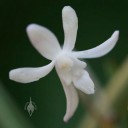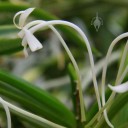Samurai Orchid
Centuries before the western world became fascinated with orchids, some eastern cultures were cultivating and revering them. For over 400 years, Japanese have grown fuu ran, the “wind orchid.” It’s known in English as Neofinetia, or the Samurai Orchid. This mini species is native to mountainside forests in southern Japan, southern Korea, and eastern China. Japanese nobles and samurai admired its beauty, elegance, and serenity. Over time, its admirers also lent this species the Japanese name fuuki ran, “rich and noble orchid.”
The Samurai Orchid has charming, bird-like flowers, and a rich, sweet vanilla scent in the evening. Its small size, tolerance for cold, and close relation to the Phal and Vanda families make it a popular choice as an orchid hybrid parent. Ascofinetia, Neostylis, and Darwinara are just a few of the hybrids with Neofinetia roots.
Japanese growers have been especially fascinated by the Samurai Orchid’s natural variations in flower colors, leaf colors, and leaf shapes. Typically, the flowers are pure white, but rare color mutations have been discovered and cultivated. Flower forms now come in yellow, green, pink, and magenta. Diminutive green leaves in a fan pattern are most common, but some varieties have leaves with stripes or splotches of color. Others have twisted leaves and even misshapen flowers. The rarest forms can sell for thousands of dollars.
Nowadays in Japan, Samurai Orchids are beloved as cultural treasures, and often grown in moss in traditional bonsai pots. They require shade, frequent water, and warm temps in the summer. During winter dormancy, they need full sun, less water, and cool temps.
Many people are surprised that samurai cared so much for these tiny plants. Best known, of course, for their warrior skills, they also cultivated artistic talents, such as calligraphy, painting, music, or raising wind orchids. My friends and family know that orchids aren’t my only obsession — I’ve been studying Aikido, a Japanese martial art, for over 2 decades. I’m not a samurai, but I am happy to honor this artistic tradition in my training. I’m especially proud when my Neofinetia blooms, and I can enjoy an emblem of samurai history.
Explore posts in the same categories: Dormancy, Fragrant Orchids, Intermediate Growers, Mini Orchids, Photos, Watering
Subscribe to the About Orchids Blog:
![]()












October 11th, 2010 at 6:15 pm
Great blog post!
October 13th, 2010 at 7:44 pm
I love the shape of the flower. Those are remarkable little flowers. Thanks so much for this interesting post!
October 25th, 2010 at 6:24 am
I’ve been away from the internet, but wanted to jump in late on this post to say: great post! Fantastic photos!
I’d add that, although the delicacy of the flowers seems at odds with the toughness of the samurai who coveted them, retrieving this hard-to-find species from the wild was seen as super brave and daring. I have the appropriate links on my cat/orchid blog: http://catsandcatts.blogspot.com/2009/12/samurai-kitty.html
You clearly have a better touch with this species than I do. I have one that I’ve moved from coconut husk to pine bark — from outside in the summer to inside — with a catt-like watering schedule to a Paph.-like schedule. It’s the only vanda-type I have in my collection and I can’t figure out its watering needs. It’s not dying, it’s just not thriving. But your photos give me hope of what it could become — so thanks!
October 29th, 2010 at 1:51 pm
Sorry for my bad english. Thank you so much for your good post. Your post helped me in my college assignment.
February 8th, 2011 at 8:43 am
Thanks for writing so informative post. Cheers
February 19th, 2011 at 8:12 pm
Thanks a lot for remarkably superb website. It’s always so cool plus stuffed with a good time for me and my office acquaintances to search your blog really 3 times in a week to learn the fresh guidance you have. Not to mention, we are certainly contented with your unbelievable suggestions you give. Some 4 points in this posting are easily the best we’ve had.
March 26th, 2011 at 7:19 pm
[…] Even though a few dry days went over 8o°F (27°C,) the Masdevallias, Odonts, and Samurai Orchids were ok.[…]